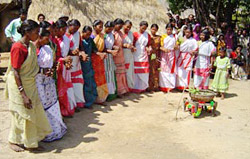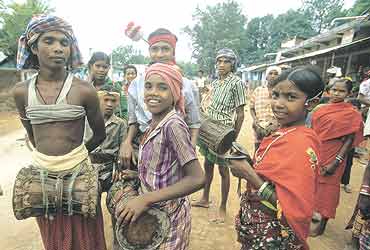


Tribals of Jharkhand

Copyright © visitindia.org.in 2011-12. All Rights Reserved.
More info on Jharkhand
From the legendary Asurs and Santhals, to the Banjara, Birhor, Chero, Gond, Ho, Khond, Lohra, Mal Pahariya, Munda, Oraon, Kol or Kawar over 32 tribal groups ie around 28% of the population of the state have left their impression on the culture of the region. The cross cultural influences of Buddhism and Jainism, Mughal rule and the Hindu emperors of Bengal are also seen here. Art historians ascribe the 'oldest cave paintings' of India the scroll paintings to a Jharkhand tribe known as the Shabars who today live on the verge of extinction. It is an established fact that the Stone age tools discovered in Hazaribagh district and axes and spearheads found in the Chaibasa area, are remnants of a civilization dating back to thousands of years. 10,000 to 30,000 year old rock paintings in huge caves in the Sati hills and other indicators od ancient, even pre-historic, human settlements are found in profusion.
Marriage rituals are elaborate and full of community rejoicing. Births of boys are girls are treated joyous. Santhals philosophy puts acceptance of death very high and funeral and mourning rites are seriously observed. Religious beliefs and practise range from animism to following Christian and Hindu faiths. The principal deities are - Sing Bonga, Marang Buru and Jaher-era. Ritual sacrifices are also used in worship.
The Asurs
One of the most primitive tribal communities they are known for their centuries old 'iron smelting' skills. Men and women work together, eat together, take care of their offspring together and struggle to earn bread for their families together.
The Mundas
Another Austro-Asiatic race, ranked in the third position by way of population in Jharkhand, they are said to have migrated from the north-western parts after the Aryan invasion. Munda women are very fond of ornaments and wear a great deal of it in their bodies. Family units are structured on the belief and co-operation of its members. Relationships between husband and wife, parents and children are very strong.
The Gonds
The Gonds are the most populous tribal community with a major concentration in Madhya Pradesh. They are usually forest fringe dwellers, with strong family kinship based on love and affection. Marriage, birth are happy occasions, women are the custodians of culture, norms and values in the Gond society.
The Khonds & Koras
These are minor tribal groups but with distinctive cultural features. They are of the Dravadian descent.
The Lohars
As the name itself signifies loha means iron, this group are great blacksmiths and create iron-items of exquisite artistic and utilitarian value.
The Birhors
This is a nomadic tribe, known for their monkey-trapping capabilities. They dwell on high hill tops or the outskirts of the forests. Those who dwell in clusters of makeshift huts and enjoy blissful family lives are known as Jaghis Bihar, and the wandering groups are called Utlelan Birhor.
The Mahalis
Composed of sub sects the Bansphor are expert basket makers, Patar Mahali are associated with basket making and cultivation, the Sulunkhi Mahali survive on cultivation and labour, the Tanti Mahal are traditional 'palanquin' bearers, and the Munda Mahalis are cultivators. Mahalis usually maintian excellent relationships with lineage, clan and tribe.
The Chickbaraiks
Spinners and weavers as a community, Chickbaraiks live in villages along with other tribes and castes. The women like to adorn themselves with jewellery. Family units are strong and division of labour is done according to age and sex.
The Birjias & The Baigas
These are minor scheduled tribes, still dependant upon forest resources. They live in deep forest and inaccessible agricultural areas. In recent times they have discarded shifting cultivation. The Baigas were first discovered in 1867 and described as wild and living inaccessible hills and remote forest areas. Baigas previously did not till the land because they thought that it would hurt mother earth.
The Banjaras
This is another group that stands threatened by rapidly dwindling numbers. Their villages are located near hills and forests. They are skilled weavers and make mats, baskets, trays, brooms etc from grass growing wild in the forest. They move residence often and in a group. They alos go around villages to sing prayers on the birth of a child. They constitute the smaller tribal population in Jharkhand.

The Santhals
Santhals dominate Jharkhand's tribal population. They have a unique heritage of tradition, suprisingly sophisticated customs and tastes and a lifestyle with folk danse and music. The Santhal language is elaborate, structured and has a recognized script 'Alchiki' perhaps unmatched by any other tribal community. The innate sophistication of the Santhal's are also evident in their family patterns - patriachal, nuclear with a strong husband wife as well as sibling relationship.
